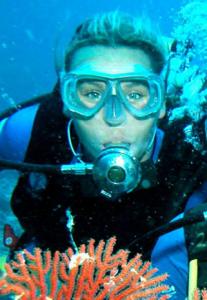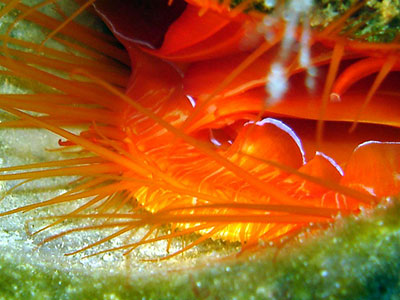
Growing up in land-locked Colorado, my childhood experiences involved more snowmen than sand-castles. Although my interactions with the ocean were limited, my fascination with the marine world grew exponentially with every exposure. After becoming SCUBA certified at the age of 15, diving became an integral part of my life, leading me to become an instructor in Zanzibar, Tanzania. After living in Africa and Australia, I conducted research on artificial coral reef systems in Indonesia, assessing the relationship between structural characteristics and diversity. I also helped with high-altitude limnology research in Colorado assessing the effects of anthropogenic fish introduction on trophic cascades.
When choosing a PhD program, Integrative Biology at Berkeley was incredibly appealing not only for the academic diversity inherent in the program, but also for the immense potential for collaboration. I chose to work under Dr. Roy Caldwell, whose marine lab graduate student studies range from the ecology of underwater cave systems to parental care in mantis shrimp to octopus defense behavior to sea otter historical ecology. The freedom and support to pursue a course of research that holds great personal interest is a unique and invaluable component of this program.
 In my first year, I was able to engage in depth with the biomechanics program through the Center for Integrative Biomechanics in Education and Research, analyze high-speed video and spectrometry in collaboration with the Elias Lab, conduct ultrastructure research through the Electron Microscope Lab, and do molecular phylogenetic work through the University of California Museum of Paleontology.
In my first year, I was able to engage in depth with the biomechanics program through the Center for Integrative Biomechanics in Education and Research, analyze high-speed video and spectrometry in collaboration with the Elias Lab, conduct ultrastructure research through the Electron Microscope Lab, and do molecular phylogenetic work through the University of California Museum of Paleontology.
My current research centers on the use of visual communication channels in the ocean’s variable photic environment. With greater depth, long wavelengths are absorbed rapidly, yet many organisms use visual displays that require ambient light for reflection. I am currently studying Ctenoides ales, which are bivalves that live at depths up to 20m inside small crevices. Despite their light-limited habitat, they evolved an iridescent mantle edge that flashes bright blue light, leading to their common name “electric scallops”. They are the only species of bivalve known to have a light display. The behavioral purpose of the light display remains unknown, and I am testing the hypotheses that the light display acts in phototaxic prey luring or as a deimatic anti-predation display. This organism is a unique example of biological engineering and the development of a sensory system that functions in a specific habitat, and I look forward to learning more about the evolutionary stressors that led to its development, the biomechanical basis that controls it, and what the intra- or inter-specific behavioral purpose behind it may be.